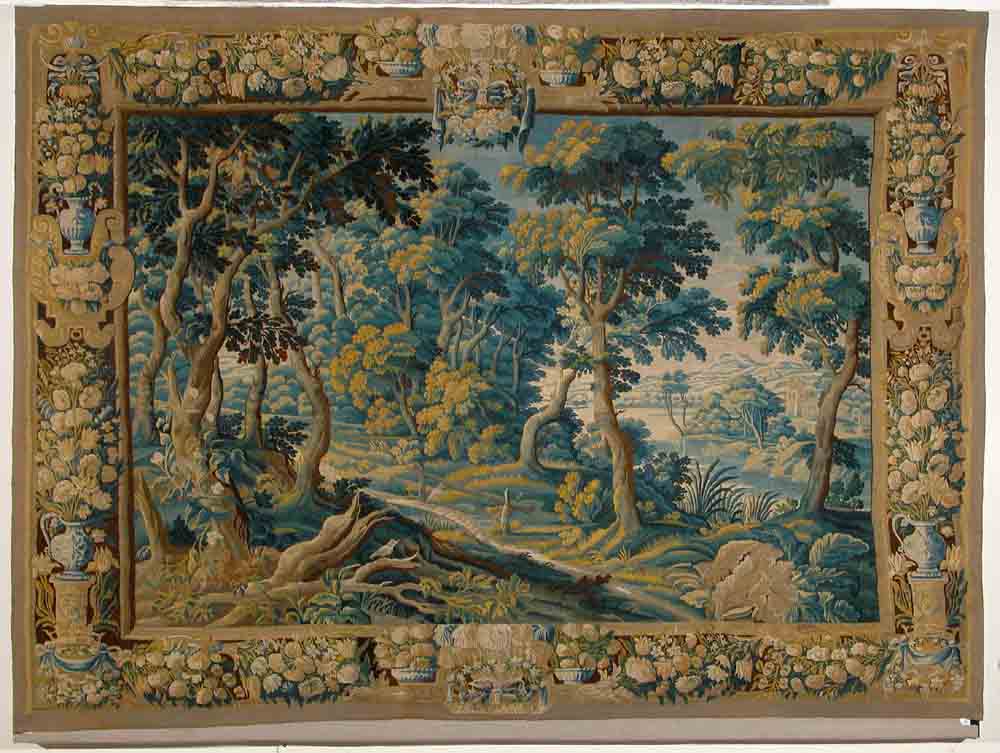There are five tapestries in the fabric collection of the Castle Museum in Malbork. All of them were made in Flanders (Brussels, Oudenaarde, Antwerp) in the period from the end of the 16th century to the beginning of the 18th century.
Tapestry is a monumental multi-colored decorative fabric with figural, landscape-plant or heraldic representations. In Polish terminology, tapestries created between the fourteenth and sixteenth centuries are commonly called tapestries, and those later, from the seventeenth and eighteenth centuries – tapestries. The first term comes from the French city of Arras, famous for its tapestry production; the second – after the dyers Gobelins, whose part of the property was attached to the Manufacture Royale des Gobelins founded in Paris in 1662. The universal term “tapisserie” refers to both of these types of fabrics. In old Poland, terms such as carpets, lines, tires were also used. Tapestries developed in the cool, humid climate of the North, where they replaced wall frescoes, so popular in southern Europe. They were used to decorate and insulate castle, palace or church interiors. Woven on looms, one-sided, usually wool and silk, sometimes with the addition of silver or gold threads, they took up historical, biblical, mythological and hagiographic themes. They were created in whole thematic series on the canvas of cardboard boxes by the best painters. The first production of the series – editio princeps, guaranteed the highest quality. Subsequent replicas, using the same cardboard boxes, often differed from the original both in terms of workmanship and in a trimmed form. There are over 400 fabrics of this type in the Polish collection; most of them are of Flemish origin, which reflects the 300-year dominance of South Holland in the production and trade of tapestries.
There are five tapestries in the fabric collection of the Castle Museum in Malbork. All of them were made in Flanders (Brussels, Oudenaarde, Antwerp) in the period from the end of the 16th century to the beginning of the 18th century.
Three ancient men, Brussels, late 16th century, wool, silk, sign. BB, inv. No. MZM / TK / 67
The tapestry presents three unknown ancient warriors. In the center, the main character in rich Roman armor of the lorica squamata type. In his hand he holds a regiment, a sign of authority; a golden helmet is decorated with a laurel wreath. In the background a military scenery: foot and horse soldiers in armor, with swords and spears, numerous military tents. A wide border, typical for Brussels fabrics. There are eight bucolic (allegorical?) Scenes in arcades, enriched with grotesque, alternating with bouquets of flowers and fruit in vases.
Jacob on his way to Canaan, Oudenaarde, c. 1560-1590, sheep wool, silk, inv. No. MZM / TK / 66
A scene from a series of performances telling the story of the biblical Jacob. The patriarch leaves his uncle and father-in-law at the same time – Laban. On his way to the land of Canaan he is accompanied by both his wives: Leah and Rachel, the minor son Joseph, and numerous servants and shepherds leading herds of camels, rams and sheep. A simultaneous composition: Rachel, shown walking vigorously by her husband’s side, appears at the same time as a woman sitting on a horse and hiding under her coat the house idols stolen from her father – “idols”. The wide border is filled with allegorical figures, bunches of flowers and fruit. In the collection of the Bowes Museum in Great Britain there is a similar tapestry, woven according to the same cardboard, which is part of another edition of the same thematically series.
Landscape verdure, Oudenaarde (?), 17th / 18th century, wool, cotton, inv. No. MZM / TK / 6
Verdure (French verdure – green) is a type of tapestry plant and landscape composition, often forest, floral or deciduous, with animal, human or architectural motifs. The Malbork fabric shows an oak forest with a vast, primeval landscape visible in the clearing, with fancifully twisted trunks and bare tree roots. In the distance, among the vegetation, there is a small architectural staffage: a one-story pavilion flanked by a pair of turrets. A wide border with a flower garland and vases.
Prof. Ewa Witkowicz-Pałka

